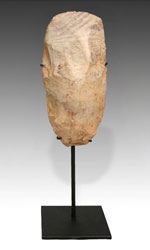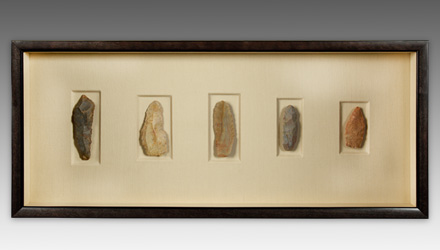Prehistoric Knapped Blades or Tools
 |
|
From the 19th century archaeologists began turning up and categorizing
 |
|
The earliest stone tools in the life span of the genus “Homo” are Mode 1 tools, which come from the Olduwan Industry in Africa, mentioned above. In these tools only one end was shaped. The earliest known Olduwan tools date from 2.6 million years ago. Eventually, more complex, Mode 2 tools began to be developed through the Acheulean Industry. These tools appear to be hand
The famous archaeologists who were the prime excavators at Olduvai Gorge, Louis and Mary Leakey, defined a “developed Oldowan” period based on evidence of an overlap in the Oldowan and Acheulean, or Modes 1 and 2. In the existing species specific view, the Oldowan related to Homo Habilis, an extinct species considered to be one of the earliest ancestors of modern humans and the earliest hominid to make tools. The Acheulean tools, like those in the Primitive collection related to Homo Erectus, which means “upright man,” the species widely considered to be the ancestor of modern man or Homo Sapien. Because dating on Homo Erectus was pushed back before the development of Acheulean tools, the Leakeys argued Homo Erectus must have initially used Mode 1 tools. In other words, there was no reason to think Mode 1 tools were strictly the province of Homo Habilis. This led to great arguments in the archeological community, although there is no debate that Homo Habilis and Homo Erectus co-existed at the same time. Whether the tools in Primitive’s collection come from man’s earliest or next to earliest ancestors is immaterial, for there is no debate they provide real evidence of humankind’s ingenuity, resourcefulness, and will to survive.
 |
|
Download this Article: Prehistoric Knapped Blades or Tools.pdf